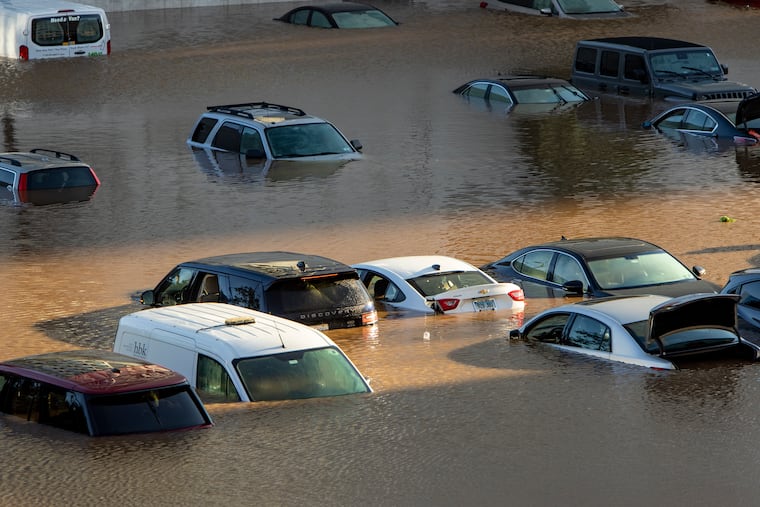A Schuylkill flood that outdid Ida’s occurred in 1869. It got ugly in Philly and Montco.
The record flooding of Oct. 4, 1869, somehow withstood Ida’s challenge. Here is why that is so remarkable ... and scary.

As damaging and disruptive as the Ida-related downpours were last month, it is entirely possible that the region could experience a worse rainstorm.
Evidently, it already did, at least once.
The Schuylkill’s record 17-foot crest of Oct. 4, 1869, linked to the so-called Saxby Gale, withstood an impressive challenge from Ida’s remnants last month.
Under the circumstances, that’s quite remarkable.
The Ida rains came on presoaked soils and atop the region’s legions of roads, driveways, roofs, patios, and other paved surfaces that provided steroidal assists to the flooding.
» READ MORE: A timeline of Ida’s Philly destruction
Saxby followed a severe drought. And predating highways, malls, big-box stores, office parks, and mega-houses, the rains fell upon carriage roads and a far less developed, less hardened landscape. Just a whole lot of dirt.
To envision rain falling on ground vs. concrete, says Villanova disaster specialist Stephen Strader, think of pouring water atop a sponge as opposed to directly onto a hard-top table.
Yet in 1869, enough water engorged the Schuylkill to submerge freight cars, bury the Fairmount Water Works dam, create frightening spectacles of the raging river, and knock out the city’s water supplies, according to newspaper and historical accounts.
Every street from Market to Callowhill, from 22nd to the Schuylkill was underwater. This was the age in which the horse was a chief means of transportation, so we’ll say you wouldn’t want to be swimming in that water, and leave it at that.
A comparable rainstorm today would be far more destructive, and not just because of climate change — or more specifically, increased moisture generated by worldwide warming — said Strader.
» READ MORE: Ida’s fatal power didn’t shock scientists who study how climate change primed the pump
“We know storms are producing greater rainfall rates,” he said, but “the atmosphere is only half the picture. The other side is how society is changing, and that’s changing even more rapidly than the climate.”
The Saxby Gale
The Inquirer, always a model of restraint, called it “the greatest flood on record.” It told of “bridges carried away, factories and dwellings inundated,” and “immense destruction of property.”
In his account, Philadelphia Water Department historian Adam Levine wrote: “Empty freight cars were washed off their tracks, barges were torn loose from their moorings and floated downstream. Riverfront factories and houses and taverns were flooded to their second stories.”
The storm took its name from a naval officer credited with predicting it. It was an offshore north-moving hurricane that paralleled the New Jersey coast. While it gained celebrity for the damage it caused in the Canadian Maritimes, its drive-by damage was evident in the Philadelphia region.
Rain fell in a three-day period ending on Oct. 4. It’s impossible to know how much of it was directly related to Saxby, as opposed to whatever systems it was interacting with. As Paul Walker, senior meteorologist with AccuWeather Inc., said, raindrops don’t come with letters.
And, unfortunately, no verified rainfall measurements were available. A national weather network wasn’t created until 1870.
The Inquirer guessed 7 to 10 inches, amounts comparable to what fell in parts of Philadelphia’s western suburbs during Ida, but the results suggest The Inquirer was off the mark.
Also the area coverage of the heaviest rain was unknown; however, it assuredly clocked the Schuylkill basin.
“The destruction of property along the river in Norristown is very great,” and freight cars were submerged in Conshohocken, according to newspaper articles unearthed by the Montgomery County Historical Society. Accounts of flooding in Bridgeport were eerily similar to Ida’s.
Future of flooding
In the years since the Saxby flood, the areas along the Schuylkill basin have become a bit more inhabited and built upon.
» READ MORE: A flood deadlier than Ida’s devastated downtown Chester in 1971. The scars remain.
Montgomery County’s estimated population in 1870 was just over 80,000, or a tenth of what it is today. It not only had far fewer houses, but also smaller houses with less roof coverage to add to runoff.
Philadelphia was more heavily developed than its suburbs, but the population still was about half of what it is now.
As for the difference in coverage of impervious surfaces today compared with 1869, that would be incalculable, said Strader and Franco Montalto, a Drexel University professor and an expert in urban hydrology. Strader said that pre-1970 comparable estimates wouldn’t be reliable.
Strader is a proponent of the “expanding bull’s-eye” concept, in which the disaster dangers increase with enlarging populations and development in flood-prone and other areas of risk.
In fact, he said, in the scientific community some are arguing for removing the natural from the term natural disasters.